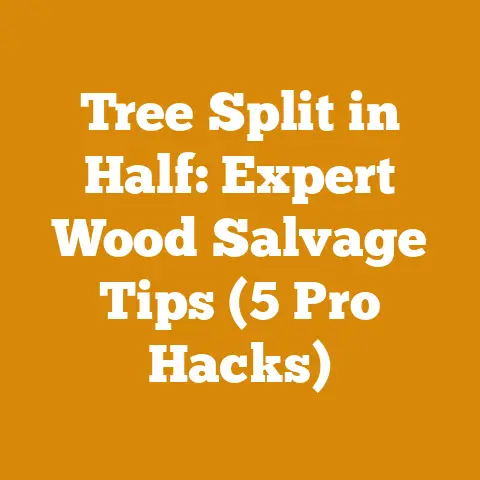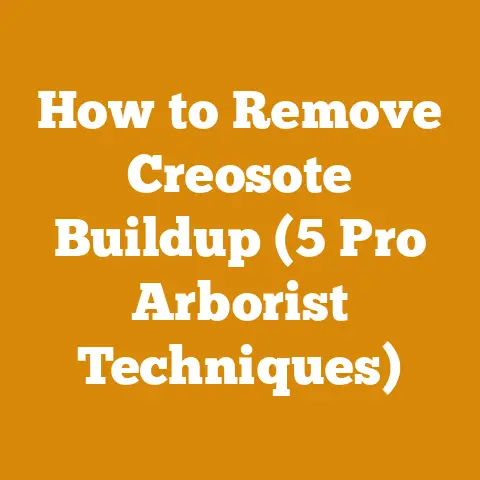Sawdust from Carpenter Ants Explained (5 Hidden Wood Pests)
In the heart of upstate New York, nestled amongst the rolling hills and dense forests, lived Eleanor Ainsworth. Eleanor wasn’t just any homeowner; she was a trendsetter, a woman who appreciated the finer things in life, especially those crafted from natural materials. Her sprawling Victorian home, a testament to her discerning taste, was filled with antique furniture, handcrafted wooden sculptures, and, of course, a roaring fireplace that demanded a steady supply of seasoned firewood. One crisp autumn morning, while admiring a newly acquired cherry wood dining table, she noticed something unsettling: tiny piles of sawdust near the table legs. Not just any sawdust, but a peculiar, fine-grained powder. This wasn’t the result of a weekend woodworking project; this was something else entirely. Eleanor, being the proactive type, immediately suspected carpenter ants and decided to delve deeper into the mystery.
Understanding Sawdust from Carpenter Ants and Other Hidden Wood Pests
Carpenter ants, termites, powderpost beetles, and old house borers are among the most common wood-destroying insects that can wreak havoc on wooden structures. Each pest leaves behind a distinctive type of sawdust, which can serve as a valuable clue to their presence.
Carpenter Ant Sawdust: A Closer Look
Carpenter ants don’t actually eat wood like termites. Instead, they excavate tunnels and galleries within the wood to create nests. The sawdust they produce, often referred to as “frass,” is a mixture of wood shavings, insect parts, and debris.
- Appearance: Carpenter ant sawdust is typically coarse and fibrous, resembling tiny wood slivers. It often contains insect body parts, such as legs, antennae, and wings, which are a dead giveaway.
- Location: Look for sawdust near entry points, such as cracks, crevices, and damp areas in wood. Carpenter ants prefer to nest in moist or decaying wood, but they can also infest sound wood. I once found a massive carpenter ant nest inside a hollow porch column that appeared perfectly sound from the outside.
- Color: The color of the sawdust can vary depending on the type of wood being infested. It can range from light brown to dark brown or even black.
Termite Frass: A Distinctive Sign
Termites, unlike carpenter ants, consume wood as their primary food source. Their frass, or droppings, is a byproduct of this digestion process.
- Appearance: Termite frass is typically small, granular, and pellet-like, resembling tiny grains of sand or coffee grounds.
- Location: Termite frass is often found near termite tunnels, also known as “mud tubes.” These tubes are constructed from soil, saliva, and excrement, providing termites with a protected pathway to their food source.
- Color: The color of termite frass can vary depending on the type of wood being consumed. It can range from light brown to dark brown or black.
Powderpost Beetle Sawdust: A Fine Powder
Powderpost beetles are small, wood-boring insects that attack seasoned hardwoods, such as oak, ash, and walnut. Their larvae bore into the wood, creating tiny tunnels and leaving behind a fine, powdery sawdust.
- Appearance: Powderpost beetle sawdust is extremely fine, almost like talcum powder. It’s often referred to as “powderpost” because of its powdery consistency.
- Location: Look for sawdust near small, round exit holes in the wood. These holes are typically 1/16 to 1/8 inch in diameter.
- Color: The color of the sawdust can vary depending on the type of wood being infested. It can range from light brown to white.
Old House Borer Sawdust: A Combination of Fine and Coarse
Old house borers are wood-boring beetles that attack seasoned softwoods, such as pine, fir, and spruce. Their larvae can cause significant damage to structural timbers in homes and buildings.
- Appearance: Old house borer sawdust is a combination of fine and coarse particles, resembling a mixture of powderpost beetle sawdust and carpenter ant sawdust.
- Location: Look for sawdust near oval-shaped exit holes in the wood. These holes are typically 1/4 to 3/8 inch in diameter.
- Color: The color of the sawdust can vary depending on the type of wood being infested. It can range from light brown to dark brown.
Identifying the Culprit: A Practical Guide
Identifying the specific type of wood pest responsible for the sawdust is crucial for implementing effective control measures. Here’s a step-by-step guide to help you determine the culprit:
- Collect a Sample: Carefully collect a sample of the sawdust using a small brush or vacuum cleaner. Be sure to wear gloves and a dust mask to avoid inhaling any potentially harmful particles.
- Examine the Sawdust: Use a magnifying glass or microscope to examine the sawdust closely. Note the size, shape, color, and texture of the particles.
- Inspect the Wood: Thoroughly inspect the surrounding wood for signs of infestation, such as entry holes, exit holes, tunnels, and mud tubes.
- Consider the Wood Type: Note the type of wood being infested. Carpenter ants and termites can attack both hardwoods and softwoods, while powderpost beetles prefer hardwoods and old house borers prefer softwoods.
- Compare to Reference Samples: Compare your sawdust sample to reference samples of sawdust from different wood pests. You can find reference samples online or at your local extension office.
- Consult an Expert: If you’re still unsure about the identity of the wood pest, consult a qualified pest control professional or entomologist. Here are some proactive measures you can take to protect your wood resources:
Wood Selection and Treatment
- Choose Durable Wood Species: Select wood species that are naturally resistant to decay and insect attack, such as cedar, redwood, and cypress. These woods contain natural oils and compounds that deter pests. For instance, Western Red Cedar heartwood has a natural resistance to decay, with a durability rating of “durable” to “very durable” according to the USDA Forest Service.
- Use Pressure-Treated Wood: Pressure-treated wood is impregnated with chemical preservatives that protect it from decay and insect attack. This is a common practice in construction, especially for ground-contact applications. The American Wood Protection Association (AWPA) sets standards for the types and levels of preservatives used in pressure-treated wood.
- Apply Borate Treatments: Borate treatments are effective against a wide range of wood pests, including carpenter ants, termites, and powderpost beetles. Borates are relatively non-toxic to humans and pets, making them a safe and environmentally friendly option. I’ve used borate treatments extensively in my own woodworking projects, particularly for outdoor furniture. A solution of disodium octaborate tetrahydrate (DOT) can be sprayed or brushed onto the wood surface.
- Kiln-Dry Wood: Kiln-drying wood reduces its moisture content, making it less attractive to wood pests. Most wood pests prefer moist wood, so keeping the wood dry is an effective prevention strategy. Kiln-drying typically reduces the moisture content to between 6% and 8%, which is ideal for preventing decay and insect infestation.
Moisture Control
- Maintain Proper Ventilation: Ensure adequate ventilation in crawl spaces, basements, and attics to prevent moisture buildup. Install vents or fans to promote airflow and reduce humidity levels. The International Residential Code (IRC) specifies minimum ventilation requirements for crawl spaces, typically requiring 1 square foot of vent area for every 150 square feet of crawl space area.
- Repair Leaks Promptly: Repair any leaks in roofs, plumbing, and foundations to prevent water from entering the building. Water damage can create ideal conditions for wood pests to thrive. I once had to replace an entire section of subfloor due to a hidden plumbing leak that had attracted carpenter ants.
- Direct Water Away from the Foundation: Ensure that gutters and downspouts are properly installed and maintained to direct water away from the foundation. This will help prevent water from seeping into the soil and creating a moist environment around the building.
- Use Vapor Barriers: Install vapor barriers in crawl spaces and basements to prevent moisture from rising from the ground. Vapor barriers are typically made of polyethylene plastic and should be installed over the entire floor of the crawl space or basement.
Preventative Maintenance
- Remove Wood Debris: Remove any wood debris, such as stumps, branches, and firewood, from around the foundation. These materials can serve as a breeding ground for wood pests and attract them to the building.
- Store Firewood Properly: Store firewood away from the house, preferably on a raised platform and covered with a tarp. This will help keep the firewood dry and prevent it from becoming infested with wood pests. I always recommend storing firewood at least 20 feet away from the house.
- Seal Cracks and Crevices: Seal any cracks and crevices in the foundation, siding, and around windows and doors. This will help prevent wood pests from entering the building. Use caulk or sealant to fill any gaps or openings.
- Regular Inspections: Conduct regular inspections of your home and property for signs of wood pest infestation. Pay close attention to areas that are prone to moisture, such as crawl spaces, basements, and bathrooms.
Treating Wood Pest Infestations: Effective Solutions
If you discover a wood pest infestation, it’s important to take action promptly to prevent further damage. Here are some effective treatment options:
Chemical Treatments
- Liquid Insecticides: Liquid insecticides can be applied to the soil around the foundation to create a barrier that prevents termites from entering the building. These insecticides are typically applied by a pest control professional and can provide long-term protection. Common active ingredients include termiticides like fipronil and imidacloprid.
- Foam Insecticides: Foam insecticides can be injected into wall voids and other hard-to-reach areas to kill carpenter ants and other wood pests. The foam expands to fill the voids, ensuring that the insecticide reaches all of the pests.
- Dust Insecticides: Dust insecticides can be applied to cracks and crevices to kill powderpost beetles and other wood-boring insects. The dust adheres to the insects’ bodies and is ingested as they groom themselves. Boric acid dust is a commonly used option.
Non-Chemical Treatments
- Heat Treatment: Heat treatment involves raising the temperature of the infested wood to a lethal level for the pests. This can be done using specialized heating equipment or by enclosing the entire building and heating it to a high temperature. Heat treatment is an effective option for treating large infestations, but it can be expensive and may not be suitable for all situations. The lethal temperature for most wood pests is around 120°F (49°C) for a sustained period of time.
- Microwave Treatment: Microwave treatment uses microwave energy to heat the infested wood and kill the pests. This is a relatively new technology, but it has shown promising results in treating wood pest infestations.
- Biological Control: Biological control involves using natural enemies of wood pests to control their populations. For example, nematodes, which are microscopic worms, can be used to kill termites and other wood-boring insects.
Professional Pest Control
In many cases, the best option for treating a wood pest infestation is to hire a qualified pest control professional. Pest control professionals have the knowledge, experience, and equipment to accurately identify the pest, assess the extent of the infestation, and recommend the most effective treatment options. They can also provide preventative measures to help protect your home from future infestations.
Case Studies: Real-World Examples
To illustrate the principles discussed above, let’s examine a few case studies:
Case Study 1: Carpenter Ant Infestation in a Log Cabin
A homeowner in the Adirondack Mountains noticed piles of coarse sawdust near the base of several log walls in their log cabin. Upon closer inspection, they discovered carpenter ants nesting within the logs.
- Diagnosis: The sawdust was identified as carpenter ant frass based on its coarse texture and the presence of insect body parts.
- Treatment: The homeowner hired a pest control professional who injected foam insecticide into the carpenter ant nests. The homeowner also took steps to reduce moisture around the foundation and seal cracks and crevices in the logs.
- Outcome: The carpenter ant infestation was successfully eradicated, and the log cabin was protected from further damage.
Case Study 2: Powderpost Beetle Infestation in Antique Furniture
An antique furniture collector noticed small piles of fine, powdery sawdust beneath several pieces of furniture in their collection. They suspected a powderpost beetle infestation.
- Diagnosis: The sawdust was identified as powderpost beetle frass based on its fine, powdery texture and the presence of small, round exit holes in the wood.
- Treatment: The collector treated the infested furniture with a borate solution, applying it to all surfaces and into the exit holes. They also wrapped the furniture in plastic to contain the borate fumes and prevent re-infestation.
- Outcome: The powderpost beetle infestation was successfully controlled, and the antique furniture was preserved.
Case Study 3: Termite Infestation in a Residential Home
A homeowner in Florida discovered mud tubes running along the foundation of their home. They suspected a termite infestation.
- Diagnosis: The mud tubes were identified as termite tunnels, and the homeowner contacted a pest control professional for further inspection. The pest control professional confirmed the presence of termites and recommended a liquid insecticide treatment.
- Treatment: The pest control professional applied a liquid insecticide to the soil around the foundation, creating a barrier that prevented termites from entering the building. They also treated any exposed wood with a borate solution.
- Outcome: The termite infestation was successfully eradicated, and the homeowner was able to protect their home from further damage.
Technical Specifications and Requirements
To ensure successful wood processing and pest prevention, it’s essential to adhere to specific technical specifications and requirements.
Wood Moisture Content
- Ideal Moisture Content for Interior Wood: 6-8%
- Ideal Moisture Content for Exterior Wood: 9-14%
- Maximum Moisture Content for Firewood: 20%
- Measurement Method: Use a moisture meter to accurately measure the moisture content of wood. Insert the probes into the wood and read the digital display.
- Technical Limitation: Wood with a moisture content above the recommended levels is more susceptible to decay and insect attack.
Wood Preservative Application
- Borate Solution Concentration: 10-15% solution of disodium octaborate tetrahydrate (DOT) in water.
- Application Method: Apply the solution liberally to all surfaces of the wood, using a brush, sprayer, or immersion method.
- Application Rate: Apply enough solution to thoroughly wet the wood, typically around 1 gallon per 200 square feet.
- Technical Limitation: Ensure that the wood is dry before applying the borate solution. Allow the solution to dry completely before painting or staining the wood.
Tool Calibration Standards
- Chainsaw Chain Tension: Adjust the chain tension so that it can be pulled away from the guide bar by about 1/8 inch.
- Chainsaw Carburetor Adjustment: Adjust the carburetor according to the manufacturer’s instructions to ensure proper fuel-air mixture.
- Moisture Meter Calibration: Calibrate the moisture meter according to the manufacturer’s instructions to ensure accurate readings.
- Technical Limitation: Properly calibrated tools are essential for safe and efficient wood processing.
Safety Equipment Requirements
- Chainsaw Safety: Wear a chainsaw helmet with face shield and ear protection, chainsaw chaps, gloves, and boots.
- Wood Preservative Application: Wear gloves, eye protection, and a respirator when applying wood preservatives.
- Dust Control: Wear a dust mask when working with sawdust or other wood particles.
- Technical Limitation: Always wear appropriate safety equipment to protect yourself from injury.
Conclusion: Protecting Your Wood Resources
Sawdust from carpenter ants and other hidden wood pests can be a serious threat to the integrity of wooden structures and furniture. By understanding the different types of sawdust, identifying the culprit, implementing preventative measures, and taking prompt action when infestations occur, you can protect your valuable wood resources and ensure their longevity. Remember, proactive maintenance and regular inspections are key to preventing wood pest infestations and preserving the beauty and value of your wood assets.






